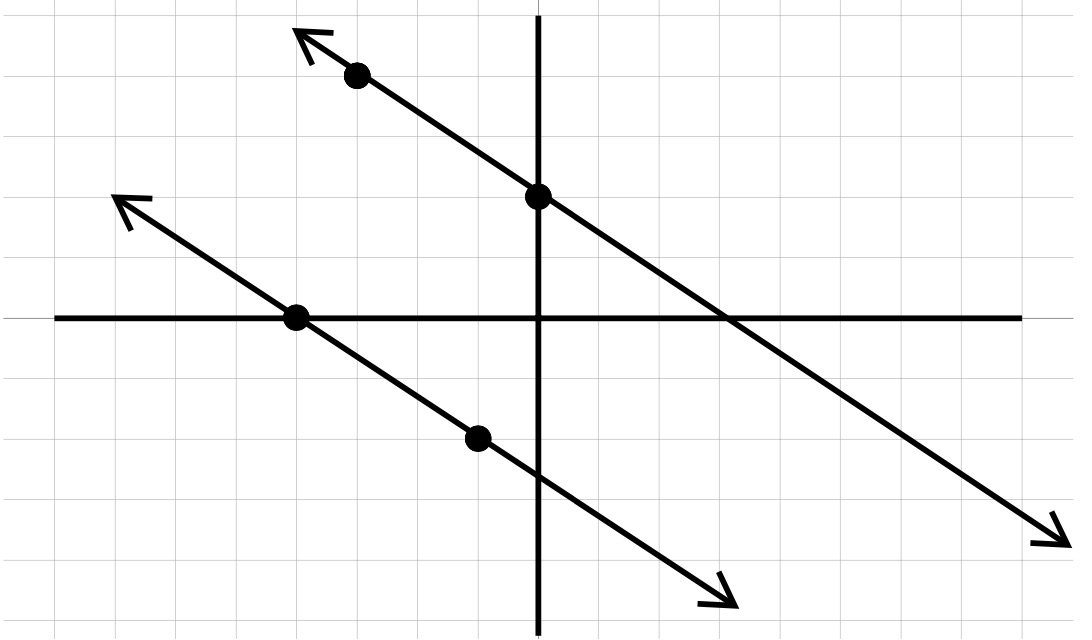Section 2.5 Parallel and Perpendicular Lines
There is an interesting connection between the slope of lines that are parallel and the slope of lines that are perpendicular (meet at a right angle). This is shown in the following example.
Example 2.5.1.


World View Note: Greek Mathematician Euclid lived around \(300\) BC and published a book titled, The Elements. In it is the famous parallel postulate which mathematicians have tried for years to drop from the list of postulates. The attempts have failed, yet all the work done has developed new types of geometries!
As the above graphs illustrate, parallel lines have the same slope and perpendicular lines have opposite (one positive, one negative) reciprocal (flipped fraction) slopes. We can use these properties to make conclusions about parallel and perpendicular lines
Example 2.5.4.
Find the slope of a line parallel to \(5y - 2x = 7\text{.}\)
Example 2.5.5.
Find the slope of a line perpendicular to \(3x - 4y = 2\)
Once we have a slope, it is possible to find the complete equation of the second line if we know one point on the second line.
Example 2.5.6.
Find the equation of a line through \((4, - 5) \) and parallel to \(2x - 3y =6\text{.}\)
Example 2.5.7.
Find the equation of the line through \((6, - 9) \) perpendicular to \(y = -\frac{3}{ 5} x + 4\) in slope-intercept form.
Zero slopes and no slopes may seem like opposites (one is a horizontal line, one is a vertical line). Because a horizontal line is perpendicular to a vertical line, we can say that no slope and zero slope are actually perpendicular slopes!
Example 2.5.8.
Find the equation of the line through \((3, 4) \) perpendicular to \(x = - 2\)
Being aware that to be perpendicular to a vertical line means we have a horizontal line through a \(y\) value of \(4\text{,}\) thus we could have jumped from this point right to the solution, \(y =4\text{.}\)
Exercises Exercises - Parallel and Perpendicular Lines
Exercise Group.
Find the slope of a line parallel to each given line.
1.
\(y = 2x +4 \)
2.
\(y = -\frac{2}{ 3} x + 5 \)
3.
\(y = 4x -5 \)
4.
\(y = -\frac{10}{3} x - 5 \)
5.
\(x - y = 4 \)
6.
\(6x - 5y = 20 \)
7.
\(7x + y = -2 \)
8.
\(3x +4y = -8 \)
Exercise Group.
Find the slope of a line perpendicular to each given line.
9.
\(x =3 \)
10.
\(y = -\frac{ 1 }{2} x -1 \)
11.
\(y = -\frac{ 1}{ 3} x \)
12.
\(y =\frac{ 4}{ 5} x \)
13.
\(x - 3y = -6 \)
14.
\(3x - y = - 3 \)
15.
\(x +2y =8 \)
16.
\(8x - 3y =-9 \)
Exercise Group.
Write the point-slope form of the equation of the line described.
17.
through: \((2, 5)\text{,}\) parallel to \(x =0 \)
18.
through: \((5, 2)\text{,}\) parallel to \(y = \frac{7}{ 5} x + 4 \)
19.
through: \((3, 4)\text{,}\) parallel to \(y =\frac{9}{ 2} x - 5 \)
20.
through: \((1, - 1)\text{,}\) parallel to \(y = -\frac{ 3}{ 4} x + 3 \)
21.
through: \((2, 3)\text{,}\) parallel to \(y = \frac{7}{ 5} x +4 \)
22.
through: \(( - 1, 3)\text{,}\) parallel to \(y = - 3x -1 \)
23.
through: \((4, 2)\text{,}\) parallel to \(x =0 \)
24.
through: \((1, 4)\text{,}\) parallel to \(y = \frac{7}{ 5} x +2 \)
25.
through: \((1, -5)\text{,}\) perpendicular to \(- x + y =1 \)
26.
through: \((1, - 2)\text{,}\) perpendicular to \(-x +2y =2 \)
27.
through: \((5, 2)\text{,}\) perpendicular to \(5x + y = -3 \)
28.
through: \((1, 3)\text{,}\) perpendicular to \(- x + y = 1 \)
29.
through: \((4, 2)\text{,}\) perpendicular to \(- 4x + y = 0 \)
30.
through: \(( - 3, - 5)\text{,}\) perpendicular to \(3x + 7y = 0 \)
31.
through: \((2, - 2) \text{,}\) perpendicular to \(3y -x =0 \)
32.
through: \((- 2, 5) \text{,}\) perpendicular to \(y - 2x =0 \)
Exercise Group.
Write the slope-intercept form of the equation of the line described.
33.
through: \((4, - 3)\text{,}\) parallel to \(y = -2x \)
34.
through: \(( - 5, 2)\text{,}\) parallel to \(y =\frac{ 3}{ 5} x \)
35.
through: \(( - 3, 1)\text{,}\) parallel to \(y = -\frac{ 4}{ 3} x - 1 \)
36.
through: \(( - 4, 0)\text{,}\) parallel to \(y = -\frac{ 5}{ 4 }x + 4 \)
37.
through: \(( - 4, - 1)\text{,}\) parallel to \(y = -\frac{1}{ 2} x + 1 \)
38.
through: \((2, 3)\text{,}\) parallel to \(y =\frac{ 5}{ 2} x - 1 \)
39.
through: \(( - 2, -1)\text{,}\) parallel to \(y = -\frac{1}{ 2} x - 2 \)
40.
through: \(( - 5, -4)\text{,}\) parallel to \(y =\frac{ 3}{ 5} x - 2 \)
41.
through: \((4, 3)\text{,}\) perpendicular to \(x + y = -1 \)
42.
through: \(( -3, - 5)\text{,}\) perpendicular to \(x + 2y = -4 \)
43.
through: \((5, 2)\text{,}\) perpendicular to \(x = 0 \)
44.
through: \((5, - 1)\text{,}\) perpendicular to \(- 5x + 2y = 10 \)
45.
through: \(( - 2, 5)\text{,}\) perpendicular to \(-x + y = -2 \)
46.
through: \((2, - 3)\text{,}\) perpendicular to \(-2x +5y = -10 \)
47.
through: \((4, - 3)\text{,}\) perpendicular to \(- x +2y = -6 \)
48.
through: \(( - 4, 1)\text{,}\) perpendicular to \(4x +3y = - 9 \)